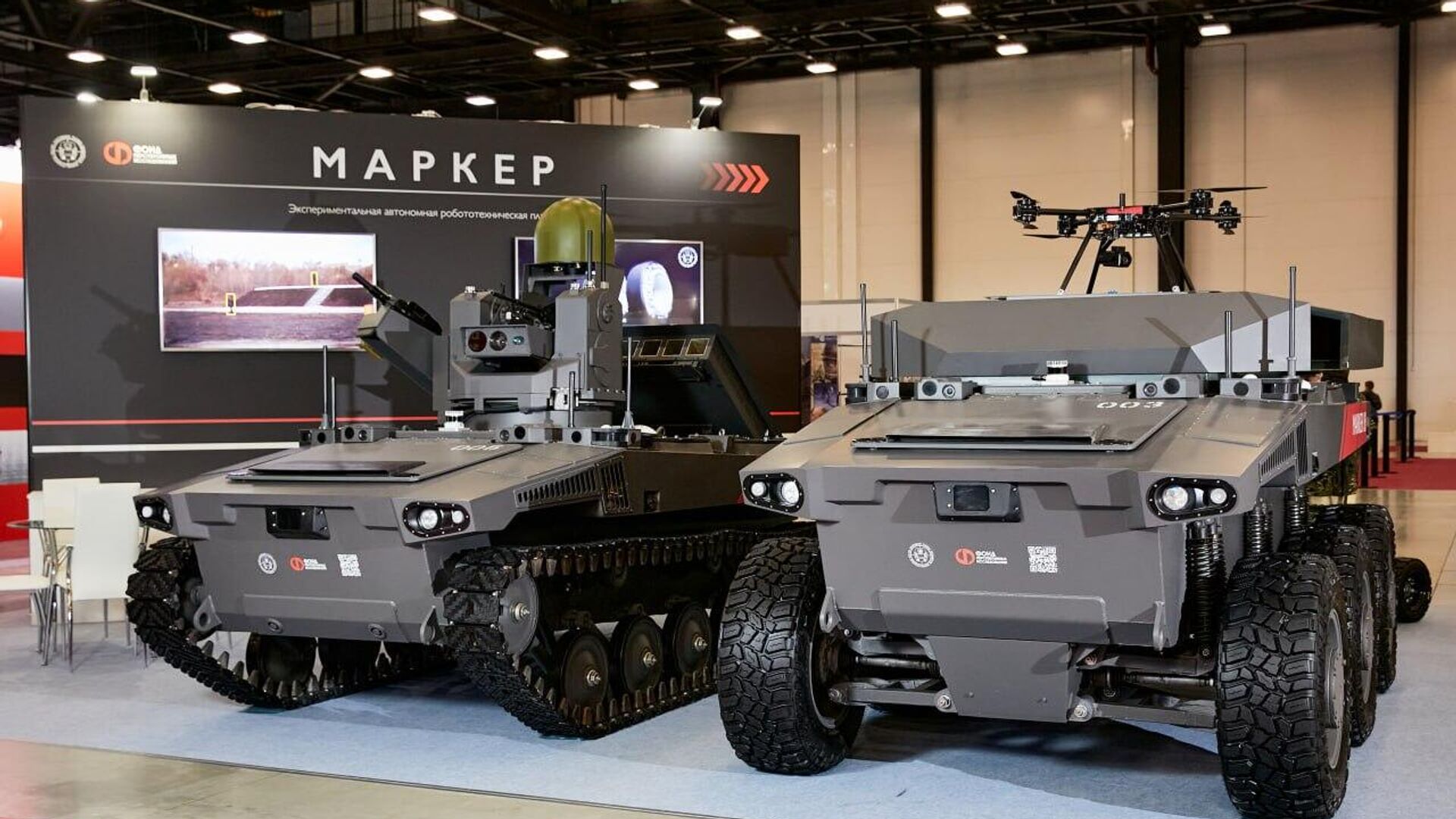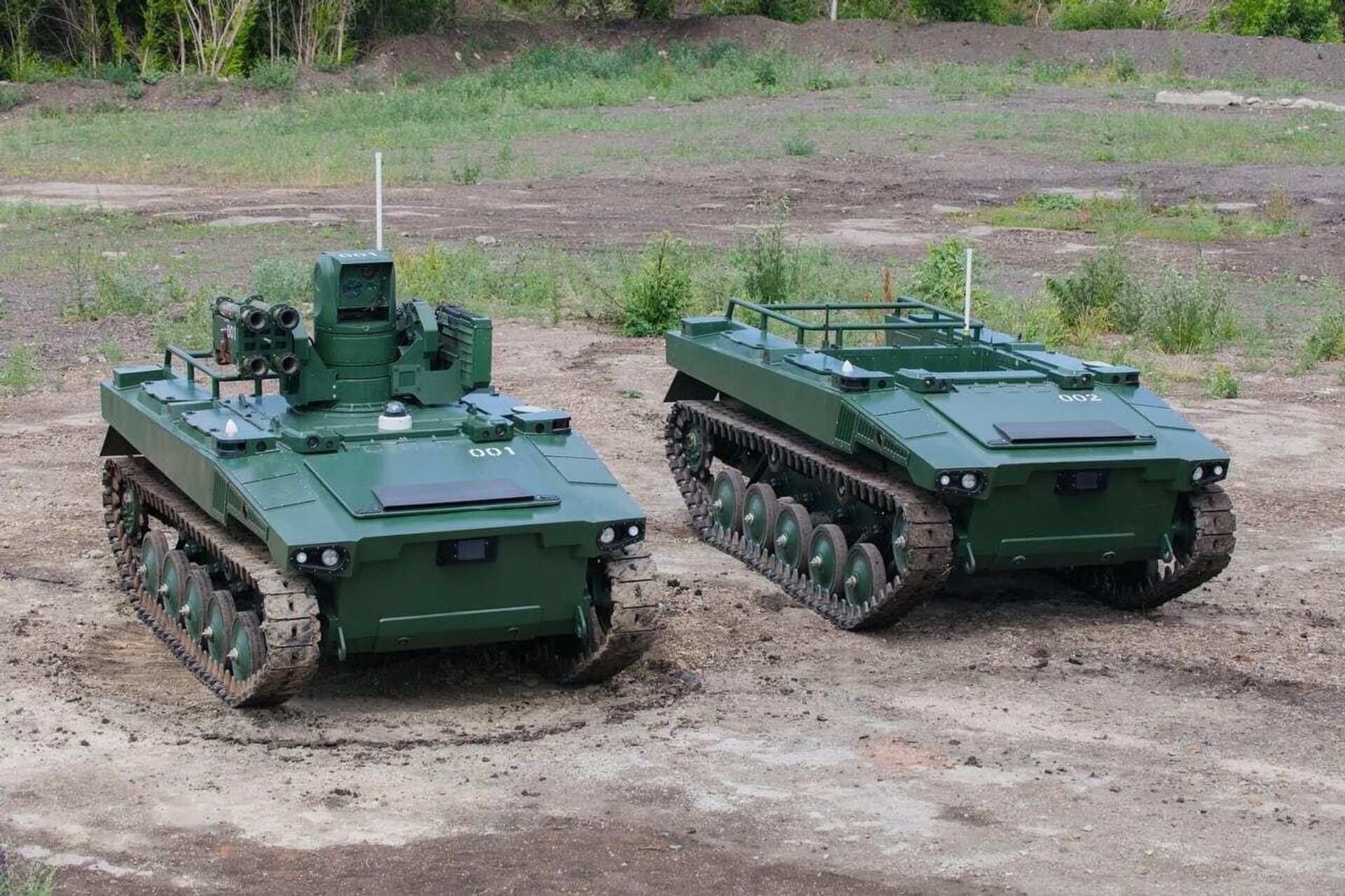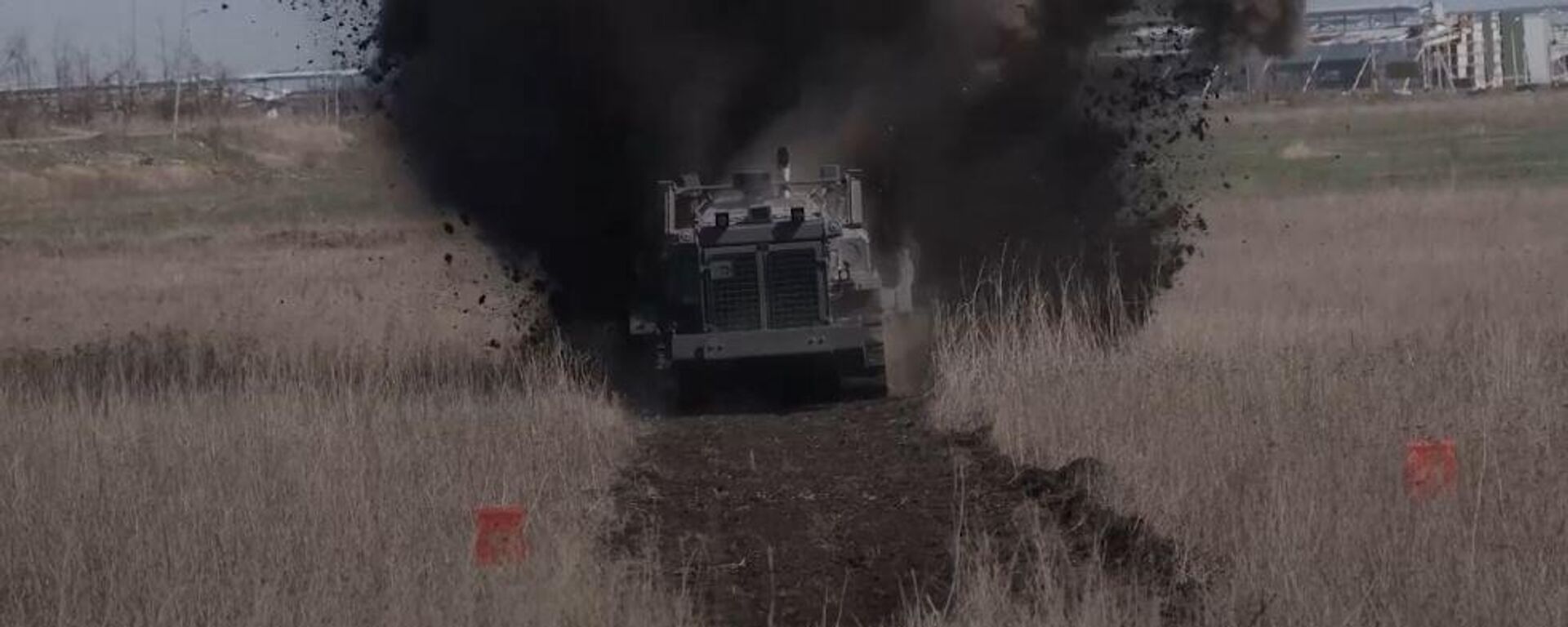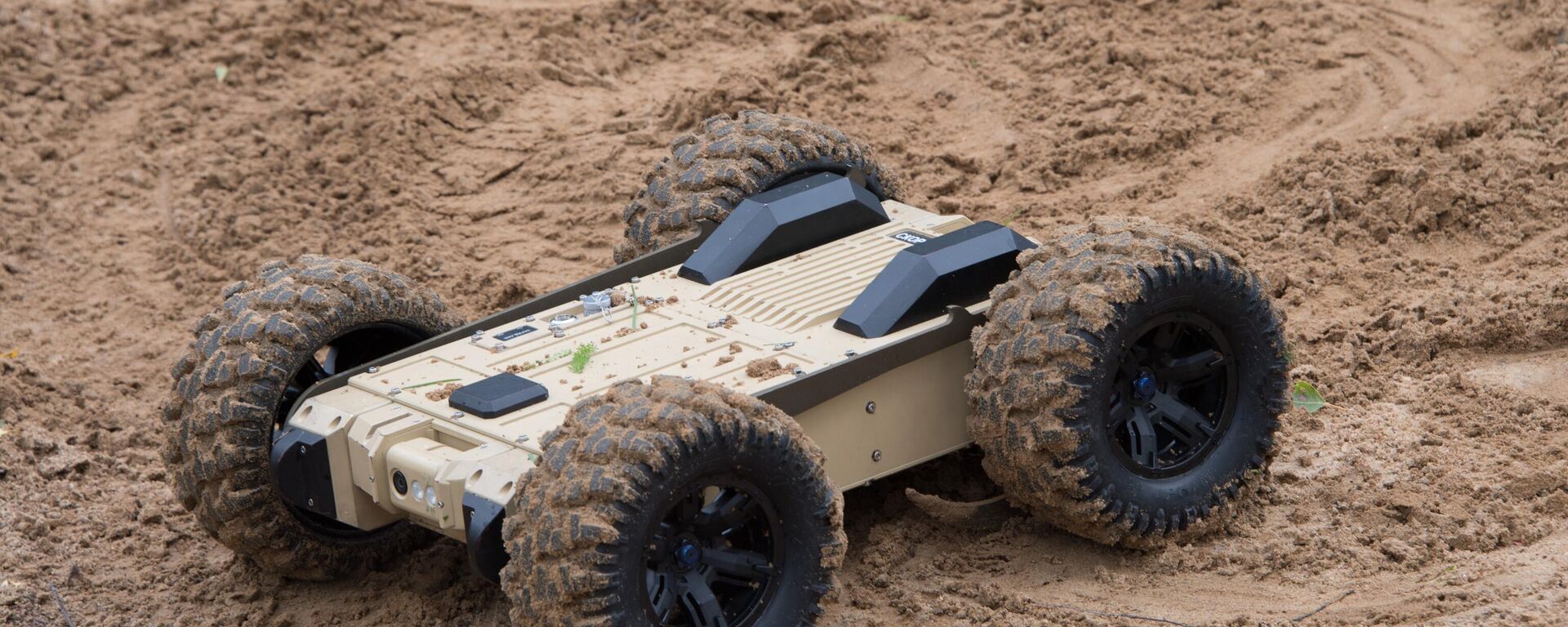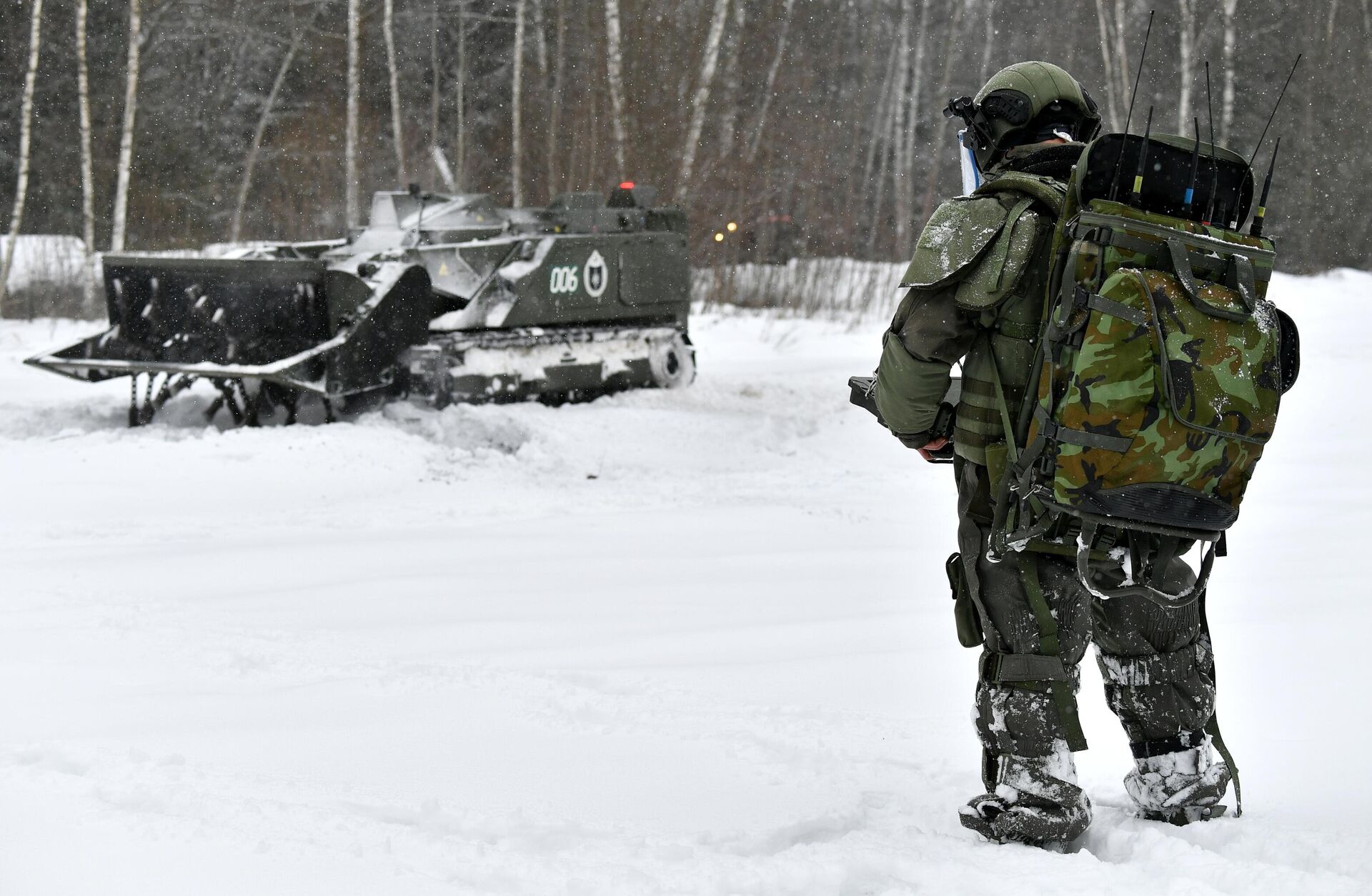https://sputnikglobe.com/20240417/russian-armys-robotization-advances-by-leaps-and-bounds-amid-ukraine-conflict-1117981229.html
Russian Army's Robotization Advances by Leaps and Bounds Amid Ukraine Conflict
Russian Army's Robotization Advances by Leaps and Bounds Amid Ukraine Conflict
Sputnik International
The high-intensity conflict in Ukraine has transformed robotic systems into an indispensable tool on the battlefield, prompting Russia's engineers to move forward in research, subsequently ushering in cutting-edge innovations.
2024-04-17T17:02+0000
2024-04-17T17:02+0000
2024-04-18T04:35+0000
russia
military & intelligence
sergei shoigu
dmitry rogozin
ukraine
donbass
lugansk
nato
robots
drones
https://cdn1.img.sputnikglobe.com/img/07e7/06/05/1110921431_0:67:1280:787_1920x0_80_0_0_dcc7dc72c09fd355a81149fab3e51737.jpg
Russian Defense Minister, Sergei Shoigu, recently looked at more than 30 promising samples of weapons and special military equipment. While conducting this examination, Shoigu placed particular emphasis on military robots, with a specific focus on a new autonomous fire support system. He issued orders that this system be upgraded with a machine gun for assault operations, underscoring its significance.Presently, Russian troops are steady advancing along the entire front line in the zone of the special military operation, making assault robots and drones (a type of robot that can be remotely controlled and used for a variety of purposes) especially handy for military personnel.Sputnik has delved into how Russia's robotic systems are changing modern warfare.MarkerLast January, Russia rolled out a combat robot to destroy NATO-grade armored vehicles in the special military operation zone. The robotic complex Marker, developed by SPA Android Technics with the support of the Advanced Research Foundation, was initially designed as a multipurpose platform.The modified version of the Marker robot is able to target and strike German and US-made main battle tanks. In February 2023, four Marker military robots were sent to Donbass. The robot's control system includes an electronic catalog containing images of targets in both visible and infrared spectrums, allowing the Marker to identify and prioritize enemy military hardware, ultimately destroying it. Dmitry Rogozin, the former director general of the Russian federal space agency Roscosmos, shared this information with Sputnik on January 26, 2023.Sosna-NRussian Special Forces operating in the combat zone have successfully utilized an anti-sniper system called "Sosna" (which translates to Pine Tree). The robotic sniper detector, Sosna-N, was developed by the Polyus Research Institute, a part of the Rostec state corporation. It was showcased for the first time at the Army-2021 forum. This automatic remote-controlled system is specifically designed to pinpoint optical and optoelectronic devices utilized for surveillance and targeting purposes. Upon detecting a sniper, the Sosna-N immediately activates an alarm signal, identifies the sniper's location, and disrupts their activities using laser radiation. The robotic system has an impressive range of up to 2.5 km and weighs just 4.6 kg.CherepakhaThe "Cherepakha" (meaning Turtle) is a wheeled cargo drone created by Argo, a Russian company, currently undergoing battlefield testing in the Lugansk People’s Republic (LPR) starting from January. This innovative system is designed to transport munitions, such as mortar shells for crews, and supplies to soldiers stationed on the front lines. With a speed comparable to that of a marching infantry unit (about 10 km/h), the Cherepakha can be programmed to autonomously follow a radio marker carried by a squad leader while carrying up to 500 kg of cargo. Additionally, its lithium-ion battery power source allows for virtually silent operation and minimal heat generation, according to the system's manufacturer.StalkerRussia's heavy automated demining system "Stalker" was tested earlier this month in the vicinity of the recently liberated town of Avdeyevka. This system is highly automated and equipped with a specialized striker trawl, enabling it to effectively neutralize both anti-tank and anti-personnel mines buried up to 30 centimeters deep. This capability ensures the safety and progress of Russian troops and armored vehicles in the region.The Stalker weighs about 27 tons and is powered by a 540 hp engine. Operators run the robot from a distance of up to 1 km with a remote control system. Being equipped with four cameras, the robot provides the crewmembers with a full picture of the battlefield.ScorpionRussia's bomb disposal units utilize a compact unmanned ground vehicle (UGV) known as the "Scorpion" for demining purposes in tight urban settings. Weighing approximately 30 kg, the Scorpion boasts a top speed of 10 km/h on pavement. Equipped with a series of cameras and an infrared illuminator, the Scorpion has the capacity to carry up to 25 kilograms of explosives in a specialized cart for controlled detonations. Its small size enables the platform to navigate underneath cars, while its rotating camera scans for explosives. Additionally, the robot's retractable manipulators allow for the neutralization of anti-personnel tripwires.Pitbull and PartisanThe Pitbull and Partisan are remote-controlled sapper bots, each designed for specific purposes. The Pitbull thrives in rough terrains with its extendable robot claw arm and winch, while the Partisan serves as a multipurpose armored tracked combat platform. Both bots can also be utilized for reconnaissance and assault missions when equipped with machine guns and various projectiles. Specifically created for the special military operation zone, these robots are currently undergoing trials. Russian arms makers are also testing a range of other demining robots, such as the "Chelnok", "Shmel" (Bumblebee), and "Prohod-1", to further enhance their capabilities.Uran Family of RobotsThe Uran is the name of a family of ground-based robotic complexes designed to assist the Russian military in the special military operation zone.The Uran-6 serves as a demining system which can operate in urban, flat, mountainous and small forested areas. The platform weighs 1 ton and is equipped with five interchangeable tools to demine a selected area; move heavy objects weighing up to one ton; remove rubble, and even build parapets. The robot is managed via radio channel from a distance of up to 800 m.The Uran-9 is an assault combat robotic system designed for reconnaissance and fire support for Russian military personnel on various types of terrain, including urban areas. The platform is equipped with the 2A27 30 mm automatic cannon, a machine gun, a flamethrower as well as anti-tank missiles and can be operated remotely from a distance of up to 3 km.The Uran-14 is a versatile, remote-controlled fire-fighting system designed to operate in challenging and hazardous environments. It is equipped with two-ton water tanks and 600-liter foam-forming agent tanks, allowing it to access difficult-to-reach locations with ease.The Russian Armed Forces are fully embracing robotization, taking advantage of the valuable experience gained during encounters with both Ukrainian and foreign military forces armed with advanced NATO-grade weapons and unmanned vehicles. The intense nature of these battles has spurred Russian designers to make significant technological advancements at a surprisingly rapid pace.
https://sputnikglobe.com/20230126/russia-rolls-out-combat-robot-to-detect-and-destroy-leopard-2-abrams-tanks-sent-to-ukraine-1106724932.html
https://sputnikglobe.com/20240113/new-turtle-wheeled-drone-starts-delivering-shells-to-russian-forces-in-ukrainian-conflict-zone-1116146705.html
https://sputnikglobe.com/20240408/giant-russian-stalker-robot-clears-mines-near-avdeyevka-1117810803.html
https://sputnikglobe.com/20240408/pint-sized-hero-russias-scorpio-helps-clear-away-ukrainian-booby-traps-1117810701.html
https://sputnikglobe.com/20240401/russias-first-ever-mass-ground-drone-attack-heralds-further-robotization-of-warfare-1117683977.html
russia
ukraine
donbass
lugansk
Sputnik International
feedback@sputniknews.com
+74956456601
MIA „Rossiya Segodnya“
2024
News
en_EN
Sputnik International
feedback@sputniknews.com
+74956456601
MIA „Rossiya Segodnya“
Sputnik International
feedback@sputniknews.com
+74956456601
MIA „Rossiya Segodnya“
russian military robots, russian robotic killers of leopard tanks, russian marker robot, russian assault military robots, stalker demining robots, robotization of warfare in ukraine, war in ukraine, drones in ukraine, ukraine conflict revolutionized drone warfare
russian military robots, russian robotic killers of leopard tanks, russian marker robot, russian assault military robots, stalker demining robots, robotization of warfare in ukraine, war in ukraine, drones in ukraine, ukraine conflict revolutionized drone warfare
Russian Army's Robotization Advances by Leaps and Bounds Amid Ukraine Conflict
17:02 GMT 17.04.2024 (Updated: 04:35 GMT 18.04.2024) The high-intensity conflict in Ukraine has transformed robotic systems into an indispensable tool on the battlefield, prompting Russia's engineers to move forward in research, subsequently ushering in cutting-edge innovations.
Russian Defense Minister, Sergei Shoigu, recently looked at more than 30 promising samples of weapons and special military equipment. While conducting this examination, Shoigu placed particular emphasis
on military robots, with a specific focus on a new autonomous fire support system. He issued orders that this system be upgraded with a machine gun for assault operations, underscoring its significance.
Presently, Russian troops are steady advancing along the entire front line in the zone of the special military operation, making assault robots and drones (a type of robot that can be remotely controlled and used for a variety of purposes) especially handy for military personnel.
Sputnik has delved into how Russia's robotic systems are changing modern warfare.
Last January, Russia rolled out a combat robot to destroy
NATO-grade armored vehicles in the special military operation zone. The robotic complex Marker, developed by SPA Android Technics with the support of the Advanced Research Foundation, was initially designed as a multipurpose platform.
The modified version of the Marker robot is able to target and strike German and US-made main battle tanks. In February 2023, four Marker military robots were sent to Donbass. The robot's control system includes an electronic catalog containing images of targets in both visible and infrared spectrums, allowing the Marker to identify and prioritize enemy military hardware, ultimately destroying it. Dmitry Rogozin, the former director general of the Russian federal space agency Roscosmos, shared this information with Sputnik on January 26, 2023.
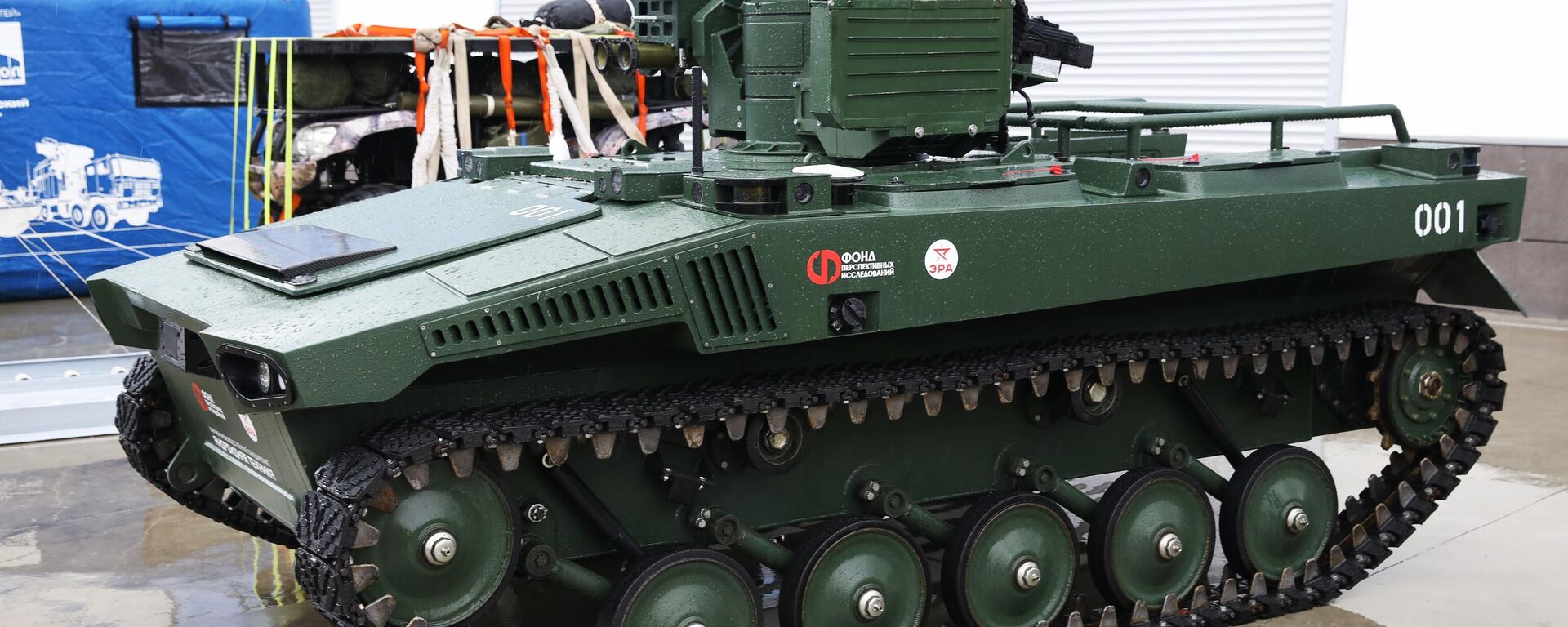
26 January 2023, 11:32 GMT
Russian Special Forces operating in the combat zone have successfully utilized an anti-sniper system called "Sosna" (which translates to Pine Tree). The robotic sniper detector, Sosna-N, was developed by the Polyus Research Institute, a part of the Rostec state corporation. It was showcased for the first time at the Army-2021 forum.
This automatic remote-controlled system is specifically designed to pinpoint optical and optoelectronic devices utilized for surveillance and targeting purposes. Upon detecting a sniper, the Sosna-N immediately activates an alarm signal, identifies the sniper's location, and disrupts their activities using laser radiation. The robotic system has an impressive range of up to 2.5 km and weighs just 4.6 kg.
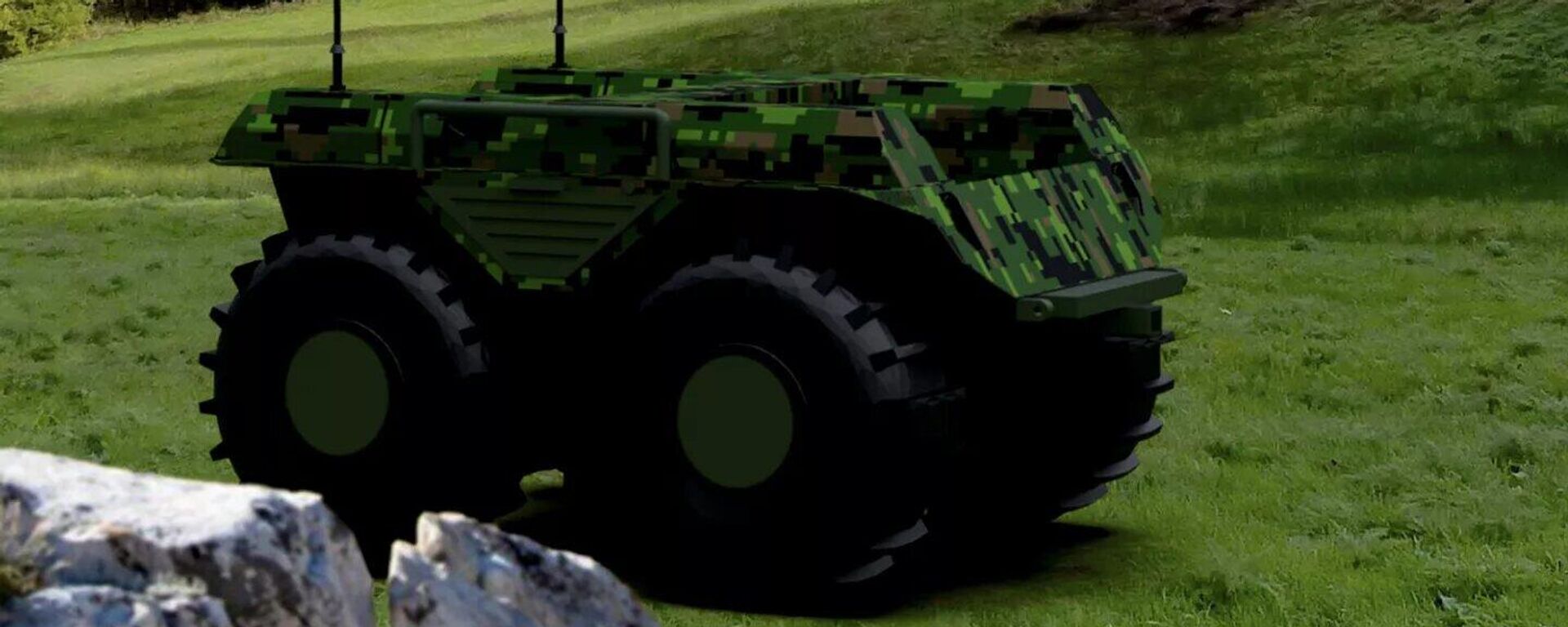
13 January 2024, 17:50 GMT
The "Cherepakha" (meaning Turtle) is a wheeled cargo drone created by Argo, a Russian company, currently undergoing battlefield testing in the Lugansk People’s Republic (LPR) starting from January. This innovative system is designed to transport munitions, such as mortar shells for crews, and supplies to soldiers stationed on the front lines.
With a speed comparable to that of a marching infantry unit (about 10 km/h), the Cherepakha can be programmed to autonomously follow a radio marker carried by a squad leader while carrying up to 500 kg of cargo. Additionally, its lithium-ion battery power source allows for virtually silent operation and minimal heat generation, according to the system's manufacturer.
Russia's heavy automated demining system "Stalker" was
tested earlier this month in the vicinity of the recently liberated town of Avdeyevka. This system is highly automated and equipped with a specialized striker trawl, enabling it to effectively neutralize both anti-tank and anti-personnel mines buried up to 30 centimeters deep. This capability ensures the safety and progress of Russian troops and armored vehicles in the region.
The Stalker weighs about 27 tons and is powered by a 540 hp engine. Operators run the robot from a distance of up to 1 km with a remote control system. Being equipped with four cameras, the robot provides the crewmembers with a full picture of the battlefield.
Russia's bomb disposal units utilize a compact unmanned ground vehicle (UGV) known as the
"Scorpion" for demining purposes in tight urban settings. Weighing approximately 30 kg, the Scorpion boasts a top speed of 10 km/h on pavement.
Equipped with a series of cameras and an infrared illuminator, the Scorpion has the capacity to carry up to 25 kilograms of explosives in a specialized cart for controlled detonations.
Its small size enables the platform to navigate underneath cars, while its rotating camera scans for explosives. Additionally, the robot's retractable manipulators allow for the neutralization of anti-personnel tripwires.
The Pitbull and Partisan are
remote-controlled sapper bots, each designed for specific purposes. The Pitbull thrives in rough terrains with its extendable robot claw arm and winch, while the Partisan serves as a multipurpose armored tracked combat platform.
Both bots can also be utilized for reconnaissance and assault missions when equipped with machine guns and various projectiles. Specifically created for the special military operation zone, these robots are currently undergoing trials. Russian arms makers are also testing a range of other demining robots, such as the "Chelnok", "Shmel" (Bumblebee), and "Prohod-1", to further enhance their capabilities.
The Uran is the name of a family of
ground-based robotic complexes designed to assist the Russian military in the special military operation zone.
The Uran-6 serves as a demining system which can operate in urban, flat, mountainous and small forested areas. The platform weighs 1 ton and is equipped with five interchangeable tools to demine a selected area; move heavy objects weighing up to one ton; remove rubble, and even build parapets. The robot is managed via radio channel from a distance of up to 800 m.
The Uran-9 is an assault combat robotic system designed for reconnaissance and fire support for Russian military personnel on various types of terrain, including urban areas. The platform is equipped with the 2A27 30 mm automatic cannon, a machine gun, a flamethrower as well as anti-tank missiles and can be operated remotely from a distance of up to 3 km.
The Uran-14 is a versatile, remote-controlled fire-fighting system designed to operate in challenging and hazardous environments. It is equipped with two-ton water tanks and 600-liter foam-forming agent tanks, allowing it to access difficult-to-reach locations with ease.
The Russian Armed Forces are fully embracing robotization, taking advantage of the valuable experience gained during encounters with both Ukrainian and foreign military forces armed with advanced NATO-grade weapons and unmanned vehicles. The intense nature of these battles has spurred Russian designers to make significant technological advancements at a surprisingly rapid pace.
